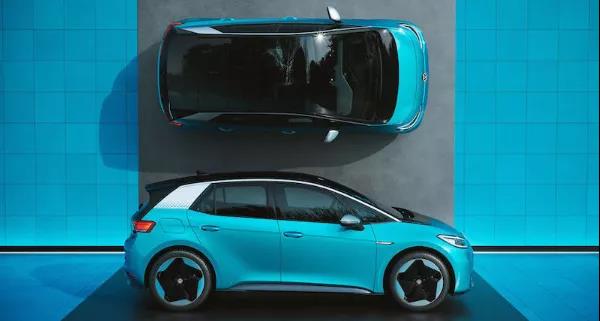In August 2020, the sales of new energy vehicles in Germany, France, the United Kingdom, Norway, Portugal, Sweden, and Italy continued to rise, up 180% year-on-year, and the penetration rate rose to 12% (including pure electric and plug-in hybrid). In the first half of this year, European new energy vehicle sales were 403,300, making it the world’s largest new energy vehicle market in one fell swoop.
(Image source: Volkswagen official website)
In the context of the new crown pneumonia epidemic and the downturn in the auto market, sales of new energy vehicles in Europe have sprung up.
According to recent data from the European Automobile Manufacturers Association (AECA), in August 2020, sales of new energy vehicles in the seven countries of Germany, France, the United Kingdom, Norway, Portugal, Sweden, and Italy continued to rise, up 180% year-on-year, and the penetration rate rose to 12. % (Including pure electric and plug-in hybrid). In the first half of this year, European new energy vehicle sales were 403,300, making it the world’s largest new energy vehicle market in one fell swoop.
According to a report recently released by Roland Berger Management Consulting, after more than a decade of continuous increase in sales, global auto sales have shown a slight downward trend since 2019. In 2019, sales closed at 88 million units, a year-on-year decrease of more than 6%. Roland Berger believes that the global new energy vehicle market will further increase its volume, and the overall industrial chain has great potential for development.
Roland Berger global senior partner Zheng Yun recently said in an exclusive interview with a reporter from China Business News that the sales of new energy vehicles in Europe have bucked the trend and are largely driven by policies. The European Union recently raised its carbon emission standard from 40% to 55%, and the restricted carbon emissions are close to Germany’s annual emissions, which will further boost the development of the new energy industry.
Zheng Yun believes that this will have three impacts on the development of the new energy industry: first, the internal combustion engine will gradually withdraw from the stage of history; second, new energy vehicle companies will further accelerate the layout of the entire industry chain; third, electric Integration, intelligence, networking, and sharing will become the general trend of automobile development.
Policy-driven
Zheng Yun believes that the development of the European new energy vehicle market at this stage is mainly driven by the government’s fiscal and tax incentives and the restriction of carbon emissions.
According to calculations conducted by Xingye, due to the relatively high taxes and fees imposed on petrol vehicles in Europe and the subsidies for electric vehicles in various countries, the purchase cost of electric vehicles for consumers in Norway, Germany and France is already lower than that of petrol vehicles (10%-20% on average). %).
“At this stage, the government has sent a signal that it wants to actively promote environmental protection and new energy projects. This is good news for auto and parts companies that have a presence in Europe.” Zheng Yun said, specifically, vehicle companies , Component suppliers, infrastructure providers such as charging piles, and digital technology service providers will all benefit.
At the same time, he believes that whether the future growth of the European new energy vehicle market can continue depends on three factors in the short term: First, whether the cost of electricity consumption can be effectively controlled so that the cost of using new energy vehicles is equal to that of fuel vehicles; Second, can the cost of high-voltage direct current charging be reduced; third, can mobile driving technology break through.
The medium and long-term development depends on the intensity of policy promotion. He added that in terms of subsidy policies, 24 of the 27 EU countries have introduced new energy vehicle incentive policies, and 12 countries have adopted a dual incentive policy of subsidies and tax incentives. In terms of limiting carbon emissions, after the EU introduced the most stringent carbon emission regulations in history, EU countries still have a big gap with the 2021 emission target of 95g/km.
In addition to policy encouragement, on the supply side, major auto companies are also making efforts. Models represented by Volkswagen’s MEB platform ID series were launched in September, and US-made Teslas were shipped to Hong Kong in bulk since August, and the supply volume has increased significantly.
On the demand side, Roland Berger’s report shows that in markets such as Spain, Italy, Sweden, France, and Germany, 25% to 55% of people said they would consider buying new energy vehicles, which is higher than the global average.
“Parts export is most likely to seize the opportunity”
The selling of new energy vehicles in Europe has also brought opportunities for related industries in China. According to data from the Chamber of Commerce of Electrical and Mechanical Services, my country exported 23,000 new energy vehicles to Europe in the first half of this year, for a total of 760 million US dollars. Europe is my country’s largest export market for new energy vehicles.
Zheng Yun believes that in the European new energy vehicle market, opportunities for Chinese companies may lie in three aspects: parts exports, vehicle exports, and business models. The specific opportunity depends on the technical level of Chinese enterprises on the one hand, and the difficulty of landing on the other.
Zheng Yun said that parts exports are most likely to seize the opportunity. In the “three powers” field of new energy vehicle parts, Chinese companies have obvious advantages in batteries.
In recent years, my country’s power battery technology has made great progress, especially the energy density and material system of the battery system have improved significantly. According to the statistics recommended by the Ministry of Industry and Information Technology, the average energy density of the battery system of pure electric passenger vehicles has been continuously increased from 104.3Wh/kg in 2017 to 152.6Wh/kg, which greatly relieves mileage anxiety.
Zheng Yun believes that China’s single market is relatively large and has advantages in scale, with greater investment in R&D in technology, and more new business models that can be explored. “However, the business model may be the most difficult to go overseas, and the main problem lies in landing.” Zheng Yun said that China is already at the forefront of the world in terms of charging and swapping modes, but whether the technology can adapt to European standards and how to cooperate with European companies is still Is the problem.
At the same time, he reminded that in the future, if Chinese companies want to deploy the European new energy vehicle market, there may be a risk that Chinese vehicle companies have a low share of the high-end market, and breakthroughs may be difficult. For European and American companies, both traditional car companies and new energy car companies have already launched new energy vehicles, and their high-end models will hinder the expansion of Chinese companies in Europe.
Currently, mainstream European car companies are accelerating their transition to electrification. Take Volkswagen as an example. Volkswagen has released its “2020-2024 Investment Plan” strategy, announcing that it will increase the cumulative sales of pure electric vehicles to 26 million in 2029.
For the existing market, the market share of European mainstream car companies is also gradually increasing. The latest data from the German Automobile Manufacturers Association (KBA) shows that in the German electric car market, Volkswagen, Renault, Hyundai and other traditional car brands have close to two-thirds of the market.
According to foreign media reports, in the first half of this year, the French automaker Renault’s all-electric car Zoe won the championship in Europe, an increase of nearly 50% year-on-year. In the first half of 2020, Renault Zoe sold more than 36,000 vehicles, higher than Tesla’s Model 3’s 33,000 vehicles and Volkswagen Golf’s 18,000 vehicles.
“In the field of new energy vehicles, the future competition and cooperation relationship will become more blurred. New energy vehicles can not only benefit from the process of electrification, but also may make new breakthroughs in autonomous driving and digital services. Profit sharing among different companies, Risk sharing may be a better development model.” Zheng Yun said.
Post time: Oct-10-2020





